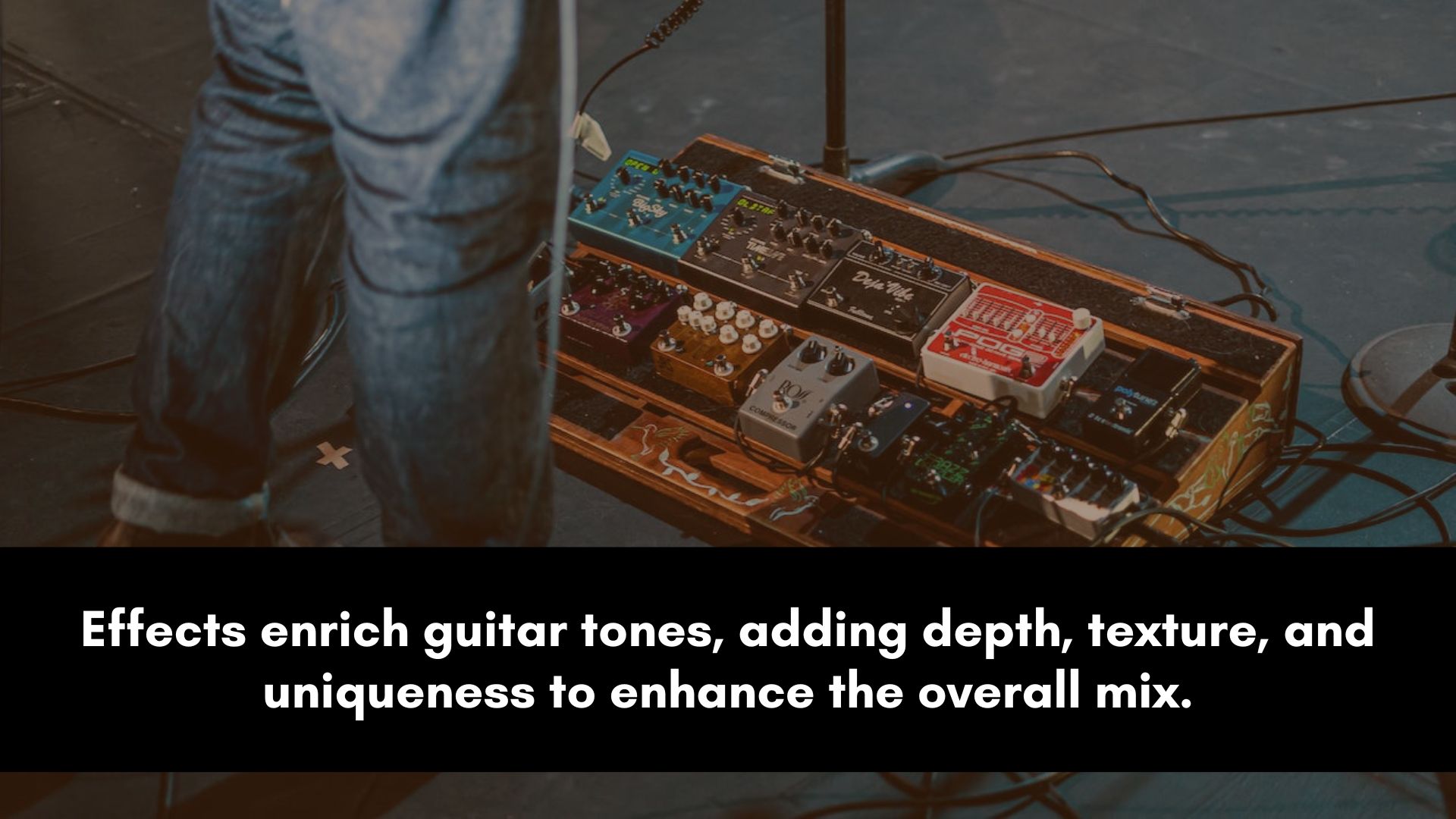Unlock the secrets of professional guitar mixing, perfect for beginners stepping into the world of mixing music.
Discover essential techniques to enhance your audio engineering journey, even if you're just starting out.
From understanding basic tools to achieving harmonious balance, this guide demystifies guitar mixing for beginners.
Mixing Guitars For Beginners

Proper mixing ensures each guitar finds its place, avoiding clutter and competition.
Without effective mixing, guitars can clash, drowning out vocals and other instruments.
The result is a muddled, unprofessional mix where the emotional impact of the music is lost.
In the next section, we delve into essential tips that can help you avoid these pitfalls.
Balancing Guitar Elements
Setting the right levels for your guitar tracks is crucial for a clean mix.
Start with the rhythm guitars. Solo one rhythm track and adjust its volume until it's clearly audible but not overpowering. Repeat for each rhythm track.
For lead guitars, ensure they shine without dominating. Solo a lead track and set its volume so it stands out yet blends.
Compare with rhythm tracks to balance. Address conflicts. When rhythm and lead clash, make tiny volume adjustments.
Trust your ears; they guide you better than numbers. Use automation for smoother transitions. Tweak during playback to fine-tune.
Acoustic guitars or ambient textures? Find their place.
Set levels so they complement, not compete. Solo and balance individually before blending. Adjust volumes moderately to retain dynamics.
Struggling? Reduce all track volumes.
Bring them up one by one until they sit just right. Trust your ears and instincts.
Regularly A/B test with a reference track. Repeat adjustments until satisfied. Balancing takes patience, but it rewards with a harmonious mix.
Equalization (EQ)
Whether you're working with electric or acoustic guitars, understanding their unique frequency ranges is essential.
When equalizing electric guitars, start by focusing on your rhythm tracks.
Identify and address any harsh or muddy qualities by making precise frequency cuts.
To add warmth and character, consider applying subtle boosts to specific frequency ranges.
For acoustic guitars EQ, the emphasis shifts towards clarity and resonance.
Begin by soloing your acoustic rhythm tracks and pinpointing any unwanted frequencies.
Address these issues by making controlled frequency reductions.
Enhance the guitar's natural richness by applying moderate boosts in strategic frequency bands.
Throughout the EQ process, remember that moderation is key.
Make gradual and deliberate adjustments while listening for the impact on the overall mix.
Guitar Compression
Compressing electric guitars requires you to focus on maintaining the rhythmic foundation.
Apply gentle compression to even out the strums and chords of rhythm guitars, providing a consistent backdrop to the mix.
The goal is to create a solid sonic base that supports other elements.
When it comes to acoustic guitar compression, it’s all about that delicate touch.
By taming sudden volume spikes, you preserve the natural dynamics of acoustic performances while ensuring they remain audible within the mix.
Strike a balance between control and preserving the instrument's organic nuances.
In lead guitar lines, compression can enhance sustain and control the peaks that occur during dynamic playing.
Apply compression with care to avoid squashing the expressive qualities of lead guitar performances.
By achieving a balance between smoothness and energy, you ensure the lead guitars cut through the mix without becoming overpowering.
Multiband compression proves useful when sculpting guitar tones.
By targeting specific frequency ranges, you can tighten the sound of both electric and acoustic guitars.
This technique helps eliminate muddiness or excessive brightness, resulting in a more focused and balanced guitar presence.
Remember, moderation is key when compressing guitars. Over-compression can strip away the natural feel and energy of the performances.
Applying Effects

Enhancing guitar tracks with well-chosen effects enriches your mix's depth and character.
Craft an immersive sound by thoughtfully integrating effects to shape spatial and tonal qualities.
Reverb imparts a sense of space to your guitars.
For tighter genres, opt for shorter decay times, while longer decays create a more expansive atmosphere.
Delays offer another avenue for sonic exploration. Short delays contribute to thickness, while longer ones craft an expansive depth.
Modulation effects like chorus, flanger, and phaser add textures. Apply subtly for enhancement without dominance.
When seeking grit and aggression, saturation can be a game-changer. Overdrive, on the other hand, imparts warmth and harmonic richness.
Embrace pedal-style effects like wah-wah, tremolo, or rotary speaker emulation to infuse your guitars with distinctive and signature characteristics.
Explore amp simulations for a wide spectrum of tonal variations.
Matching amp characteristics to the style of your song can significantly impact the overall feel and impact of your guitar tracks.
Automation of effect parameters adds dynamic interest, making your guitar parts more engaging and evolving.
Remember to maintain clarity in your guitar tracks.
While effects add flair, preserving the distinct qualities of the guitar within the mix is crucial.
Panning and Stereo Placement
Begin by envisioning the stage.
For electric and acoustic guitars, consider the listener's perspective.
Panning rhythm guitars slightly left and right achieves a natural and immersive experience.
Place lead guitars at the center to maintain focus.
If doubling the part, pan one slightly to the left and the other to the right. This tactic enhances the stereo image while retaining its core energy.
Experiment with panning to reflect the song's atmosphere.
For spaciousness, pan guitars wider. For a tighter feel, narrow the spread.
Strive for coherence, allowing each element its own sonic space without crowding.
Layering guitars? Vary the panning to avoid clutter. If two rhythm guitars occupy similar frequency ranges, pan one to the opposite side.
Use automation to add movement. As guitars interplay, automate panning to match the flow.
Remember, simplicity is effective when making your guitars sound big and wide.
Regularly listen on different systems to gauge your mix's stereo balance.
Through thoughtful panning and placement, you shape a captivating, three-dimensional mix that resonates with listeners.
Mixing Multiple Guitar Tracks
Start by categorizing your guitar tracks—rhythm, lead, ambient, etc. Organize them for easy access and reference.
Address potential conflicts by carving out sonic spaces for each guitar. Use EQ to attenuate clashing frequencies and ensure distinctiveness.
Utilize panning to differentiate guitar parts.
Pan rhythm guitars slightly to the sides for width. If you have intricate parts, consider leaving them at the center.
Avoid overwhelming the mix with selective layering. Assess the arrangement and let the essential parts shine while others support it subtly.
For dense sections, simplify. Mute or lower less crucial guitar parts to maintain clarity.
Focus on what contributes to the song's essence.
Experiment with stereo placement. Position contrasting guitar elements to occupy their own spaces, aiding separation.
Use automation to control volume and panning during dynamic passages. Guide the listener's attention through the mix's twists and turns.
Strive for a harmonious coexistence of guitar layers.
With careful organization, EQ sculpting, strategic panning, compression, and astute automation, your mix will flourish with a multitude of guitars working together in unison.
FAQ:
How do you make two guitars sound good together?
To make two guitars sound good together, focus on balance and coordination.
Ensure that each guitar has its own sonic space by using different frequency ranges.
Use EQ to remove overlapping frequencies and make them distinct.
Choose complementary tones; one can be bright while the other is warm.
Consider their roles—rhythm and lead—ensuring they complement rather than compete.
Experiment, listen, and adjust to achieve harmony. Remember, simplicity often yields the best results.
Where should guitars sit in a mix?
Guitars should sit in a mix with clarity and balance.
Rhythm guitars can be panned slightly left and right for width. Lead guitars are often centered for focus.
Consider the song's mood; wider panning adds space, while narrower maintains intimacy.
Align guitars with other elements; let bass and drums anchor the low end.
Use panning to distinguish layers, preventing muddiness. Regularly listen and adjust to achieve a cohesive sound.
How loud should guitars be in a mix?
Guitars should be loud enough in a mix to be heard clearly without overpowering other elements.
Start by setting drums and vocals as your reference points, then adjust guitars accordingly.
Rhythm guitars usually sit slightly below vocals, providing a solid foundation.
Lead guitars can be comparable to vocals, depending on their importance.
Balance is key; listen carefully and make subtle tweaks to find the right levels.